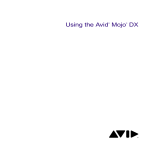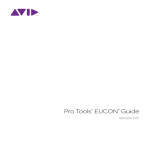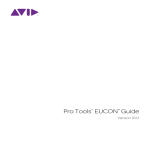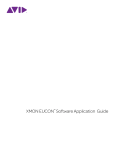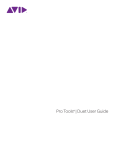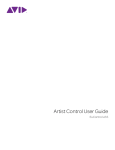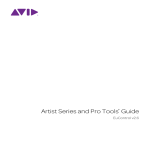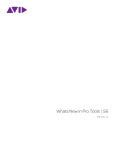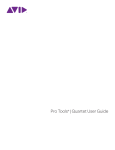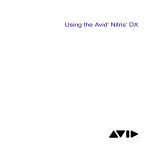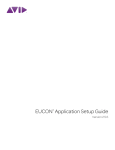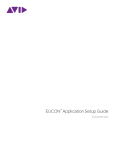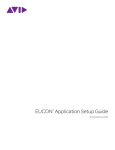Download EUCON Application Setup
Transcript
EUCON™ Application Setup Guide EuControl 3.2.2 Legal Notices © 2015 Avid Technology, Inc., (“Avid”), all rights reserved. This guide may not be duplicated in whole or in part without the written consent of Avid. 003, 192 Digital I/O, 192 I/O, 96 I/O, 96i I/O, Adrenaline, AirSpeed, ALEX, Alienbrain, AME, AniMatte, Archive, Archive II, Assistant Station, AudioPages, AudioStation, AutoLoop, AutoSync, Avid, Avid Active, Avid Advanced Response, Avid DNA, Avid DNxcel, Avid DNxHD, Avid DS Assist Station, Avid Ignite, Avid Liquid, Avid Media Engine, Avid Media Processor, Avid MEDIArray, Avid Mojo, Avid Remote Response, Avid Unity, Avid Unity ISIS, Avid VideoRAID, AvidRAID, AvidShare, AVIDstripe, AVX, Beat Detective, Beauty Without The Bandwidth, Beyond Reality, BF Essentials, Bomb Factory, Bruno, C|24, CaptureManager, ChromaCurve, ChromaWheel, Cineractive Engine, Cineractive Player, Cineractive Viewer, Color Conductor, Command|8, Control|24, Cosmonaut Voice, CountDown, d2, d3, DAE, D-Command, D-Control, Deko, DekoCast, D-Fi, D-fx, Digi 002, Digi 003, DigiBase, Digidesign, Digidesign Audio Engine, Digidesign Development Partners, Digidesign Intelligent Noise Reduction, Digidesign TDM Bus, DigiLink, DigiMeter, DigiPanner, DigiProNet, DigiRack, DigiSerial, DigiSnake, DigiSystem, Digital Choreography, Digital Nonlinear Accelerator, DigiTest, DigiTranslator, DigiWear, DINR, DNxchange, Do More, DPP-1, D-Show, DSP Manager, DS-StorageCalc, DV Toolkit, DVD Complete, D-Verb, Eleven, EM, Euphonix, EUCON, EveryPhase, Expander, ExpertRender, Fairchild, FastBreak, Fast Track, Film Cutter, FilmScribe, Flexevent, FluidMotion, Frame Chase, FXDeko, HD Core, HD Process, HDpack, Home-to-Hollywood, HyperSPACE, HyperSPACE HDCAM, iKnowledge, Impact, Improv, iNEWS, iNEWS Assign, iNEWS ControlAir, InGame, Instantwrite, Instinct, Intelligent Content Management, Intelligent Digital Actor Technology, IntelliRender, Intelli-Sat, Intelli-Sat Broadcasting Recording Manager, InterFX, Interplay, inTONE, Intraframe, iS Expander, iS9, iS18, iS23, iS36, ISIS, IsoSync, LaunchPad, LeaderPlus, LFX, Lightning, Link & Sync, ListSync, LKT-200, Lo-Fi, MachineControl, Magic Mask, Make Anything Hollywood, make manage move|media, Marquee, MassivePack, MassivePack Pro, Maxim, Mbox, Media Composer, MediaFlow, MediaLog, MediaMix, Media Reader, Media Recorder, MEDIArray, MediaServer, MediaShare, MetaFuze, MetaSync, MIDI I/O, Mix Rack, Moviestar, MultiShell, NaturalMatch, NewsCutter, NewsView, NewsVision, Nitris, NL3D, NLP, NSDOS, NSWIN, OMF, OMF Interchange, OMM, OnDVD, Open Media Framework, Open Media Management, Painterly Effects, Palladium, Personal Q, PET, Podcast Factory, PowerSwap, PRE, ProControl, ProEncode, Profiler, Pro Tools, Pro Tools|HD, Pro Tools LE, Pro Tools M-Powered, Pro Transfer, QuickPunch, QuietDrive, Realtime Motion Synthesis, Recti-Fi, Reel Tape Delay, Reel Tape Flanger, Reel Tape Saturation, Reprise, Res Rocket Surfer, Reso, RetroLoop, Reverb One, ReVibe, Revolution, rS9, rS18, RTAS, Salesview, Sci-Fi, Scorch, ScriptSync, SecureProductionEnvironment, Shape-to-Shape, ShuttleCase, Sibelius, SimulPlay, SimulRecord, Slightly Rude Compressor, Smack!, Soft SampleCell, Soft-Clip Limiter, SoundReplacer, SPACE, SPACEShift, SpectraGraph, SpectraMatte, SteadyGlide, Streamfactory, Streamgenie, StreamRAID, SubCap, Sundance, Sundance Digital, SurroundScope, Symphony, SYNC HD, SYNC I/O, Synchronic, SynchroScope, Syntax, TDM FlexCable, TechFlix, Tel-Ray, Thunder, TimeLiner, Titansync, Titan, TL Aggro, TL AutoPan, TL Drum Rehab, TL Everyphase, TL Fauxlder, TL In Tune, TL MasterMeter, TL Metro, TL Space, TL Utilities, tools for storytellers, Transit, TransJammer, Trillium Lane Labs, TruTouch, UnityRAID, Vari-Fi, Video the Web Way, VideoRAID, VideoSPACE, VTEM, Work-N-Play, Xdeck, X-Form, and XMON are either registered trademarks or trademarks of Avid Technology, Inc. in the United States and/or other countries. Bonjour, the Bonjour logo, and the Bonjour symbol are trademarks of Apple Computer, Inc. Thunderbolt and the Thunderbolt logo are trademarks of Intel Corporation in the U.S. and/or other countries. This product may be protected by one or more U.S. and non-U.S. patents. Details are available at www.avid.com/patents. Product features, specifications, system requirements, and availability are subject to change without notice. Guide Part Number 9329-65542-00 REV A 03/15 Contents Chapter 1. Introduction . . . . . . . . . . . . . . . . . . . . . . . . . . . . . . . . . . . . . . . . . . . . . . . . . . . . . . . . . . . . . . . . . . . . . . . . . . . 1 System Requirements and Compatibility . . . . . . . . . . . . . . . . . . . . . . . . . . . . . . . . . . . . . . . . . . . . . . . . . . . . . . . . . . 1 Conventions Used in This Guide . . . . . . . . . . . . . . . . . . . . . . . . . . . . . . . . . . . . . . . . . . . . . . . . . . . . . . . . . . . . . . . . 2 How to Use this PDF Guide . . . . . . . . . . . . . . . . . . . . . . . . . . . . . . . . . . . . . . . . . . . . . . . . . . . . . . . . . . . . . . . . . . . 2 Resources . . . . . . . . . . . . . . . . . . . . . . . . . . . . . . . . . . . . . . . . . . . . . . . . . . . . . . . . . . . . . . . . . . . . . . . . . . . . . . . . 3 Chapter 2. Installing EuControl Software. . . . . . . . . . . . . . . . . . . . . . . . . . . . . . . . . . . . . . . . . . . . . . . . . . . . . . . . . . . . . 4 Installing EuControl . . . . . . . . . . . . . . . . . . . . . . . . . . . . . . . . . . . . . . . . . . . . . . . . . . . . . . . . . . . . . . . . . . . . . . . . . 4 Attaching Controllers to EuControl. . . . . . . . . . . . . . . . . . . . . . . . . . . . . . . . . . . . . . . . . . . . . . . . . . . . . . . . . . . . . . . 5 Updating Controller Firmware . . . . . . . . . . . . . . . . . . . . . . . . . . . . . . . . . . . . . . . . . . . . . . . . . . . . . . . . . . . . . . . . . . 6 Powering-On Your System After Initial Setup . . . . . . . . . . . . . . . . . . . . . . . . . . . . . . . . . . . . . . . . . . . . . . . . . . . . . . . 6 Connecting a Second Workstation. . . . . . . . . . . . . . . . . . . . . . . . . . . . . . . . . . . . . . . . . . . . . . . . . . . . . . . . . . . . . . . 6 Chapter 3. Pro Tools. . . . . . . . . . . . . . . . . . . . . . . . . . . . . . . . . . . . . . . . . . . . . . . . . . . . . . . . . . . . . . . . . . . . . . . . . . . . . . 7 Enabling EUCON in Pro Tools . . . . . . . . . . . . . . . . . . . . . . . . . . . . . . . . . . . . . . . . . . . . . . . . . . . . . . . . . . . . . . . . . 7 Tips and Shortcuts . . . . . . . . . . . . . . . . . . . . . . . . . . . . . . . . . . . . . . . . . . . . . . . . . . . . . . . . . . . . . . . . . . . . . . . . . . 8 Chapter 4. Media Composer . . . . . . . . . . . . . . . . . . . . . . . . . . . . . . . . . . . . . . . . . . . . . . . . . . . . . . . . . . . . . . . . . . . . . . 12 Artist Series Controller Mappings . . . . . . . . . . . . . . . . . . . . . . . . . . . . . . . . . . . . . . . . . . . . . . . . . . . . . . . . . . . . . . 13 Common Tasks . . . . . . . . . . . . . . . . . . . . . . . . . . . . . . . . . . . . . . . . . . . . . . . . . . . . . . . . . . . . . . . . . . . . . . . . . . . 14 EUCON Application Setup Guide iii Chapter 1: Introduction The EUCON Application Setup guide helps you set up EuControl software so you can use Avid media controllers with Avid audio and video applications. Avid media controllers include the S3 control surface, Artist Transport, Artist Mix, Artist Control, and Artist Color. For other EUCON™-aware applications, see Using Avid Media Controllers with EUCON Development Partner Applications. EuControl software must be installed before connecting your Avid media controller. See the installation instructions in the Quick Setup or User Guide included with your Avid media controller to install EuControl software and your hardware if you have not already done so. System Requirements and Compatibility For the S3 control surface, see www.avid.com/S3-Surface-Support For downloads and Artist Series support, visit www.avid.com/artistsupport For Pro Tools® | S6, visit http://avid.force.com/pkb/articles/en_US/faq/Avid-S6-Support For Pro Series (System 5,S5 Fusion, Max Air, S5-MC, and MC Pro), visit www.avid.com/proseriessupport Avid can only assure compatibility and provide support for hardware and software it has tested and approved. For complete system requirements for EuControl and all other Avid products, visit: www.avid.com/compatibility Using Avid Media Controllers with EUCON Development Partner Applications The best source for information about using Avid media controllers with EUCON Development Partner applications (such as Logic and Nuendo) is the documentation provided by the manufacturer. Always check with the manufacturer of your specific application for the most recent software, requirements, and instructions. For links to EUCON Development Partners, visit http://avid.force.com/pkb/articles/how_to/EuControl-3P-Setup Upper row: Pro Tools | S3. Bottom row, left-to-right: Artist Transport, Artist Mix, Artist Control, and Artist Color Chapter 1: Introduction 1 Conventions Used in This Guide All of our guides use the following conventions to indicate menu choices and key commands: : Convention Action File > Save Choose Save from the File menu Control+N Hold down the Control key and press the N key Control-click Hold down the Control key and click the mouse button Right-click Click with the right mouse button The names of Commands, Options, and Settings that appear on-screen are in a different font. The names of keys on Artist Series hardware are in bold (such as SEL). The SHIFT key on Artist Series hardware is indicated by bold text, in all-caps (SHIFT). The following symbols are used to highlight important information: User Tips are helpful hints for getting the most from your system. Important Notices include information that could affect your data or the performance of your system. Shortcuts show you useful keyboard or mouse shortcuts. Cross References point to related sections in this guide and other Avid guides. SHIFT and SHIFT Lock The SHIFT key on Artist Series units is used in conjunction with other keys to access secondary functions that are labeled in blue above the primary function. Two SHIFT keys are located at the bottom-left and -right on both MC Control and MC Mix. MC Transport provides a single SHIFT key at the bottom-right. The following simplified terminology is used to describe SHIFT functions. Example: • “Press and hold the SHIFT key then press the AUX key” is written as • “Press SHIFT+AUX/GROUP” The SHIFT key can be locked on like caps lock on a computer keyboard by pressing both SHIFT keys simultaneously. This is useful if you plan to access several Shift functions consecutively. Press either SHIFT key to unlock. How to Use this PDF Guide These are some useful features of this PDF: • The Bookmarks on the left serve as a continuously visible table of contents. Click on a subject heading to jump to that page. • Click a + symbol to expand that heading to show subheadings. Click the – symbol to collapse a subheading. • The Table of Contents provides active links to their pages. Select the hand cursor, allow it to hover over the heading until it turns into a finger. Then click to locate to that subject and page. • All cross references in blue are active links. Click to follow the reference. • Select Find from the Edit menu to search for a subject. Chapter 1: Introduction 2 Resources The Avid website (www.avid.com) is your best online source for information to help you get the most out of your Avid system. The following are just a few of the services and features available. Account Activation and Product Registration Activate your product to access downloads in your Avid account (or quickly create an account if you don’t have one). Register your purchase online, download software, updates, documentation, and other resources. https://www.avid.com/US/account Support and Downloads Contact Avid Customer Care (technical support); download software updates and the latest online manuals; browse the Compatibility documents for system requirements; search the online Knowledge Base or join the worldwide Avid user community on the User Conference. https://www.avid.com/US/Support/index.html Training and Education Study on your own using courses available online or find out how you can learn in a classroom setting at an Avid-certified training center. Products and Developers Learn about Avid products; download demo software or learn about our Development Partners and their plug-ins, applications, and hardware. https://www.avid.com/US/Products/index.html News and Events Get the latest news from Avid. Chapter 1: Introduction 3 Chapter 2: Installing EuControl Software This chapter explains how to install EuControl software, attach your Avid media controllers, update firmware, and more. Installing EuControl To install EuControl software: 1 Visit www.avid.com/artistsupport to download the EuControl installer for your workstation computer’s platform (Mac or Windows). 2 When download is complete, locate the EuControl installer on your computer and double-click it to mount it (DMG on Mac) or uncompress it (ZIP for Windows). 3 In the resulting folder, locate and double-click the Install_EuControl file. 4 Follow the on-screen instructions to complete the installation. 5 When installation is complete, click Quit (Mac) or Finish (Windows). EuControl software on your computer launches automatically and is running when its icon appears: Mac Wait up to 60 seconds. A lit EuControl icon in the menu bar indicates correct installation and your surface is attached in EuControl. Lit EuControl icon in the Mac menu bar Windows Wait up to 60 seconds. A lit EuControl icon appears in the system tray at the bottom of the screen. If you don't see the EuControl icon, it could be automatically hidden by Windows. Click on the small white arrow to show hidden icons. EUCON icon in tool bar Hidden Icons (Windows) If the lit EuControl icon does not appear, do any of the following: • Make sure your controllers are powered on and attached. • Try the Restart EUCON Applications command: • On Mac, click the EuControl icon on the taskbar and select Restart EUCON Applications, then click Yes. • On Windows, click the EuControl icon in the Task or System tray (Windows) and select Restart EUCON Applications, then click Yes. Unused icons will be shown in the Hidden icons view. All EUCON applications are restarted, including EuControl. • Shut down your controller(s) and your computer, then turn them on (controllers first, then the workstation computer). Chapter 2: Installing EuControl Software 4 Attaching Controllers to EuControl Before you can use your controller, make sure it is attached to EuControl. Make sure you have already connected Ethernet between your controller and workstation (or router). See the installation instructions in the Quick Setup or User Guide included with your controller to connect your hardware. To attach controllers: 1 Click (Mac) or double-click (Windows) the EuControl icon and select EuControl Settings. 2 If necessary, click Surfaces to display the Surfaces tab. Surfaces tab in EuControl Settings 3 Make sure your controller appears in the My Surfaces list. If they do, see Updating Controller Firmware. 4 If your controller does not appear in the My Surfaces list, add it manually. See Adding Surfaces Manually. Adding Surfaces Manually If your controller does not automatically appear in the My Surfaces list, use the controls in the Surfaces tab to add it manually. All Surfaces All Surfaces shows all Avid media controllers on the network. A device shown in light gray is already connected either to your own or another instance of EuControl running on a different workstation. In both cases, it is not selectable. My Surfaces My Surfaces shows the media controllers connected to your instance of EuControl. The top-to-bottom order defines the left-to-right order of the surfaces, respectively. The leftmost surface is assigned to fader strip 1. Use the + and – buttons to reorder the list. Each media controller can be renamed by double-clicking the existing name and typing a new name. Add Click Add to add the selected All Surfaces entry to My Surfaces. This connects the selected Avid media controller to your instance of EuControl. You can also click and drag an Avid media controller from All Surfaces to My Surfaces. Add is disabled if all media controllers in All Surfaces are connected to any instance of EuControl. Chapter 2: Installing EuControl Software 5 Updating Controller Firmware After installing EuControl, make sure each controller is running the latest firmware. The firmware is provided within EuControl, so an Internet connection is not required. To update firmware: 1 Click (Mac) or double-click (Windows) the EuControl icon and select EuControl Settings. 2 If necessary, click Surfaces to display the Surfaces tab. 3 Click your controller in the My Surfaces list so it is highlighted. (If it is not in the My Surfaces list, see Adding Surfaces Manually.) 4 Click Update Firmware. If the Update Firmware dialog shows a message that the surface is up to date, no further action is necessary. 5 If the firmware needs to be updated, follow the instructions in the Update Firmware dialog box to proceed, and make sure to observe the following guidelines when updating firmware: • Ensure that the controller is connected to a trustworthy power source. • Do not power off the controller during the update or attempt to interrupt the update. The status of the firmware update is shown on the controller displays as well as in the EuControl dialog. 6 Click Done when the firmware update is complete, then proceed to Enabling EUCON in Pro Tools. Powering-On Your System After Initial Setup After the initial installation and setup, your system must be powered on in a specific order, as follows: 1 If connecting to a router, connect the controller to the router, connect the router to the workstation computer, and power on the router. 2 If connecting directly, connect the controller to the workstation computer. 3 Power on the controller(s). 4 Once all controllers are finished initializing, power on the workstation computer. If a controller is not recognized by EuControl on your workstation computer (for example, because you powered the controller on after powering on the workstation computer), click the unlit EuControl icon in the menu bar (Mac) or System tray (Win) and choose Restart EUCON Applications...to relaunch EuControl and re-initiate the connection. Connecting a Second Workstation Avid media controllers can control applications running on a second computer, referred to in this guide as a workstation. If EuControl is running on the same workstation as all your audio/video applications you can skip these instructions. To be able to control a second workstation: 1 Transfer the EuControl installer onto the second computer. After downloading, make sure the installer is mounted (DMG on Mac) or uncompressed (ZIP for Windows). 2 In the Extras folder, double-click the Install EuCon Workstation installer. 3 Follow the instructions to install the EuControl Workstation software. Chapter 2: Installing EuControl Software 6 Chapter 3: Pro Tools Pro Tools® and Pro Tools HD 9.0 and higher are fully EUCON-aware. This chapter explains how to configure and enable EUCON™ in Pro Tools, and shows you some common tasks to get you up and running. For more examples and workflows for Pro Tools, see the Artist Series and Pro Tools guide (installed along with other Pro Tools documentation), and the Pro Tools | S3 Guide. Enabling EUCON in Pro Tools To enable EUCON in Pro Tools: 1 Launch Pro Tools. 2 Choose Setup > Peripherals, and click to go to the Ethernet Controllers tab. 3 Click to select Enable EUCON. Enabling EUCON in Peripherals > Ethernet Controllers 4 Click OK. You do not need to configure any other Ethernet Controllers settings. These settings do not apply to EUCON. Pro Tools scans your system until it identifies attached EUCON-compatible hardware. When Pro Tools finishes scanning your system, your controllers are ready to use with Pro Tools. Using Multiple Units Multiple Avid Media Controllers Avid Media controllers can be combined to form larger, unified systems. For example, you can use up to four Artist Mix units and an Artist Control simultaneously. Similarly, S3 can be used with one Artist Transport. Pro Tools will recognize all attached units automatically. Other Units When EUCON is enabled in Pro Tools, the use of additional control surfaces is subject to the following conditions: You can use the Surround Panner Options, as well as one USB/MIDI-based control surface at the same time as EUCON. A MIDI control surface will mirror the first eight channels on your EUCON devices. You cannot use another Ethernet-based unit (such as a Pro Tools | S6 control surface) at the same time as EUCON. The only exception is that you can use an S3 and one Artist Transport simultaneously. EUCON and EuControl software 3.2.1 and later can be installed on the same workstation, but only one can be used at the same time. Chapter 3: Pro Tools 7 Confirm Installation To confirm installation and communication: 1 Make sure you have enabled EUCON as explained in Enabling EUCON in Pro Tools. 2 Open a session if one is not already open. 3 Verify the Mix window displays a blue-green border around Pro Tools tracks that are currently banked to your controller. Color outlines in the Mix window showing currently banked tracks 4 Verify that the displays on your controllers show track names, location, or other session data, depending on the unit. See the Artist Series and Pro Tools guide for system optimization recommendations. Tips and Shortcuts This section describes how to perform a few common tasks in Pro Tools using Artist Series controllers. For workflows and examples for the S3 control surface, see the Pro Tools S3 Guide. Assigning Plug-Ins To assign a plug-in: 1 Select a track. 2 Press the INSERTS key (Artist Mix) or the INSERTS encoder (Artist Control). 3 Press both PAGE keys (<PAGE and PAGE>) simultaneously. Insert slots are displayed in the Touchscreen (a, b, c, and so on), and both PAGE keys flash. 4 Press the encoder next to the desired insert slot. The Soft Encoders show the next level of choices: no insert, plug-in, or I/O (for hardware inserts, when available). 5 Press the encoder for the desired insert type. The Soft Encoders show the next level of choices such as EQ, Dynamics, Reverb, and so on. (Choices shown on your system will vary depending on which plug-ins you have installed, and the Pro Tools setting to organize plug-ins by Category or Manufacturer). 6 Press the encoder for the desired type of plug-in you want to insert. The Soft Encoders show the names of available plug-ins. Press PAGE> to see additional choices. 7 When the desired plug-in is displayed, press its encoder again to insert it on the selected track. 8 Press both PAGE keys to exit plug-in assignment. Chapter 3: Pro Tools 8 Editing Plug-In Parameters To access and edit a plug-in on Artist Mix: 1 Bank to and select the desired track by pressing its SEL key. 2 Press the INSERTS key. SOLO ON SOLO ON SOLO ON SOLO ON SOLO ON SOLO ON SOLO ON SOLO ON MC Mix INSERTS key If no plug-in is inserted in the current slot, the slot letter appears in lower-case (a, b, c, and so on). Any plug-ins in the current slot are displayed in the track LCD display. Names are abbreviated as necessary. For example, if the Avid Compressor/Limiter 3 dynamics plug-in is present in the current slot, the display above its track shows CmprsLD. 3 To view other insert slots, press PAGE> until that slot and any assigned plug-ins are displayed. 4 Press the encoder under the displayed name of the plug-in you want to edit. The first page of parameters for that plug-in are now mapped across the encoders. 5 Press PAGE> (or <PAGE) to access other parameters for the current plug-in. To access and edit a plug-in on Artist Control: 1 Bank to and select track that already has a plug-in inserted. 2 Press the INSERTS encoder. HOME SOFT KEYS END Soft Encoder for Inserts If no plug-in is inserted in the current slot, the slot letter appears in lower-case (a, b, c, and so on). If any plug-ins are already assigned in the current slot, the name of the plug-in is shown. Plug-in names are abbreviated as necessary. For example, if the Avid Compressor/Limiter 3 dynamics plug-in is present in the current slot, the display above its track shows CmprsLD. 3 To view other insert slots, press PAGE > until that slot and any assigned plug-ins are displayed. 4 Press the encoder for the plug-in you want to edit. The first page of parameters for that plug-in are mapped across the encoders. 5 Press PAGE > (or < PAGE) to access other parameters for the current plug-in. Chapter 3: Pro Tools 9 Flip to Faders (Artist Mix) Artist Mix lets you “flip” pan, plug-in, and send parameters to control them from the faders. Flipping plug-ins to the faders lets you control eight parameters (or more) simultaneously. The following example shows how to flip plug-in parameters to faders. Flip also works with pan and sends. To flip to faders: 1 Select a track that already has a plug-in inserted. 2 Press the INSERT key. 3 Push the encoder for the desired plug-in. 4 On Artist Mix, press the FLIP key (hold the SHIFT key and press CHAN/FLIP). Plug-in parameters are now at the faders. 5 Press the PAGE> key (if lit) to go to additional parameters. Press <PAGE to return to previous pages. 6 Press FLIP again to flip back to encoders. 7 Press the BACK key to close the plug-in. Flip also works with sends (AUX), pan, EQ and other knob sets. Assigning Sends To assign sends with Artist Control: 1 Select one or more tracks. 2 Press the SENDS Soft Knob. HOME SOFT KEYS END Soft Encoder for Sends 3 If desired, press the lit PAGE> key to go to sends f–j. 4 Press both PAGE keys (<PAGE and PAGE>) simultaneously, to enter Send Assign mode. 5 Press the encoder for the send slot (a–j) you want to assign. The next choices for Send assignment appear above each Soft Encoder. 6 Press an encoder to choose one of the following: no send Assigns no send bus to the selected track(s). output Displays the first page of available output busses in the encoders. bus Displays the first page of available internal busses in the encoders. 7 To see additional choices, press the lit <PAGE or PAGE> key. Chapter 3: Pro Tools 10 8 When the desired output or bus is displayed, do any of the following: • To assign to the selected track (only) press the encoder for the desired output or bus. • To assign to all selected tracks, hold Option+Shift (Mac) or Alt+Shift (Windows) on your computer keyboard and press the encoder for the desired output or bus. • To assign to all tracks, hold Option (Mac) or Alt (Windows) and press the encoder for the desired output or bus. A green dot appears indicating that send bus is now assigned to the currently selected tracks. Selecting Track Automation Mode To select the Automation mode for a track on Artist Control or Artist Mix: 1 Press the AUTO key on the desired track (hold SHIFT while pressing the track REC/AUTO key). 2 Press AUTO again to cycle to the next available automation mode such as Off, Read, Latch, or Touch. Not all modes will be available; for additional modes, use the mouse and the on-screen track Automation mode selector. Punching Out of Automation Recording To punch out of an automation pass: Press SHIFT+REC/AUTO on the desired track. Surround Panning with Artist Mix Artist Mix lets you use the encoders to control multichannel pan parameters. To pan in surround: 1 Press a track SEL key to select a track assigned to a multichannel output path (such as a 5.1 or 7.1 output path). 2 Press the PAN key. 3 Press the CHAN key. Multichannel pan parameters such as Front Left/Right, Front/Rear, divergence, pan, and center percentage appear in the Soft Encoders. As an alternative to using the encoders, hold SHIFT and press the CHAN/FLIP key to flip pan controls to the faders. Press FLIP again to return pan to the encoders. 4 Press the lit PAGE> key to show other available pan parameters. 5 Rotate an encoder to adjust it. 6 To reset a parameter to its default setting, press the encoder for that parameter. For more workflows, see the Artist Series Pro Tools Guide. Chapter 3: Pro Tools 11 Chapter 4: Media Composer The Controller Settings dialog lets you configure your Avid editing application to communicate with Avid media controllers. To configure your Avid editing application for an Avid media controller: 1 Double-click Controller Settings in the Settings list of the Project window. The Controller Settings dialog appears. The Controller Settings dialog may appear differently than then one shown above, depending on your version of Media Composer. 2 Select Controller > EUCON Controller. 3 Click OK. Configuring Ethernet Connections (Macintosh) You can connect your controller to either the Ethernet 1 or Ethernet 2 port on your Macintosh system. By default, the EuControl application is configured to use Ethernet 1. You might need to change this configuration if your system connects to a corporate network or if it is part of a shared storage environment — for example, if you connect your Macintosh system to an Avid ISIS system. For more information, see the most recent documentation that came with your Avid editing application. Configuring EuControl Settings Before you can use an Artist Series controller with your Avid editing application, you must configure the EuControl settings. In addition to establishing communication between your Artist Series units and the EuControl application on your system, EuControl Settings let you assign functions to keys and other controls on the Artist Series hardware, and connect additional applications and workstations. The EuControl application starts when you start your computer and runs in the background. Avid recommends that you make sure EuControl is running before you start your Avid editing application. For more information, see the User Guide that came with your Artist Series controller. To connect an Artist Series controller to your system: 1 Make sure you have already installed EuControl, confirmed your hardware is connected, and powered the unit on as explained in the User Guide that came with your Artist Series controller. 2 Start your Avid editing application. 3 Do one of the following: (Mac) Click the EUCON icon in the dock, and then select Window > EuControl Settings. (Windows) Double-click the EUCON icon in the notification area. Chapter 4: Media Composer 12 EuControl Settings application opens. The All Surfaces list displays all available Artist Series controllers. 4 Click the Automatically add: menu and do one of the following: • To add all controllers listed in the All Surfaces list — which lists all devices available on your subnet — select All Surfaces. This setting is useful when you are the only person running EuControl on your network. • To add only those controllers listed in the My Surfaces, select My Surfaces Only. Since only one user at a time can control a surface, this avoids claiming surfaces needed by other users on your network. The selected devices are now connected to EuControl. 5 (Option) If you select My Surfaces Only and you want to specify additional controllers to connect to your EuControl application, select a controller in the All Surfaces list, and then click Add. The controller appears in the My Surfaces list. You can rearrange the order of the controllers using the up and down arrows, and you can remove controllers from the list using the Remove button. You can also rename the controller, which allows you to easily identify multiple controllers in the My Surfaces list. 6 Click the Workstation tab. The Workstations tab opens. The All Workstations list displays all systems on your subnet that have been configured for access to the available Artist Series controllers. Managing Multiple Workstations Your computer keyboard and mouse can control a second external workstation, if desired. In EuControl software, you first enable the Redirect Keyboard and Mouse Control to Attached External Workstation option to redirect keyboard and mouse control to the attached workstation. Then you add the workstation to the My Workstations list as instructed, below. The Redirect Keyboard and Mouse Control to Attached External Workstation option must be checked before adding the workstation to the My Workstations list. If it is toggled ON after adding the workstation it will have no affect. Only workstations added with the option checked will respond. If you want more than one workstation to access your Artist Series controllers, do the following: 1 In EuControl, click to go to the Workstations tab. 2 Click to enable the Redirect Keyboard and Mouse Control to Attached External Workstation option 3 Select the workstation in the All Workstations list and click Add. 4 Select the workstation in the My Workstations list and click Attach. A check mark appears in the Attached column in the My Workstations list. The workstation can now access the Artist Series controllers connected to EuControl. 5 Close the EuControl Settings application. Note that the keyboard and mouse will no longer control your primary workstation. If this option is not selected (default setting), your keyboard and mouse control your primary computer. You can manually toggle control back and forth between your primary workstation and the attached external workstation by pressing Control+Option+\ (Mac) or Control+Alt+\ (Windows). Controller Mappings When EuControl opens for the first time, it includes a set of default Avid editing functions mapped to the Avid media controller buttons (the default mappings are called the application set, or “appset”). The Soft Keys tab controls Surface, Wheel, and Touchscreen soft key assignments. With controllers that include a Touchscreen, you can access the Surface soft keys with the circular buttons below the Touchscreen, and you can access the Touchscreen soft keys with the Soft Keys Setup Touchscreen. The mappings included in the Soft Keys tab apply only to Artist Control and Artist Transport. You can customize Soft Key assignments in EuControl software. Chapter 4: Media Composer 13 Common Tasks Moving Through Footage You can use your Artist Series controller to control how you move through footage. Depending on the functions available on your controller and the default and customizable controls, you can use the following methods: • The Jog wheel allows for frame-by-frame positioning, depending on how fast you turn the wheel right (clockwise) or left (counterclockwise). Use the Jog wheel when you want to locate a specific frame by slowly viewing footage. • You can modify the sensitivity of the Jog wheel and the Shuttle ring by adjusting parameters in the EuControl application — for example, you can set the Jog wheel to step through your footage frame by frame. For more information, see the user’s guide that came with your controller. • The Shuttle ring alters the speed of playback by how far you turn the ring. The more you turn the ring to the right, the faster the footage moves forward. To move the footage in reverse, turn the ring to the left of the midpoint position. When held in position, footage continues to moves at a fixed rate. When you release the Shuttle ring, it automatically returns to its center position and footage stops changing. Use the Shuttle ring when you want to quickly scan footage. • The Transport Controls allow you to play, pause, rewind, and fast forward in your sequence. • You can use the Rewind, Pause, and Fast Forward keys on your Artist Series controller to move through your footage as you do with J-K-L play in your Avid editing application. For more information on using the J-K-L keys, see “Playing Footage with the J-K-L Keys (Three-Button Play)” in the Help “Playing Footage with the J-K-L Keys (Three-Button Play)” on page 816. • The track selection buttons on your Artist Series controller allow you to select and deselect tracks in the Timeline. Selecting tracks in the Timeline or in the Audio Mixer tool updates the track selection display in your Artist Series controller. • You can solo and mute tracks on your Artist Series controller to isolate tracks as you monitor the audio playback. Using the solo and mute buttons on your Artist Series controller automatically updates the display in the Track Control panel and the Audio Mixer tool in your Avid editing application. You can use these buttons during playback. • Some commands only apply to specific windows in your Avid editing application. You might need to click the appropriate window — for example, the Timeline — before you can perform a specific function. For more information on moving through footage, see the documentation that came with your Artist Series controller. Automation Gain and Pan on Artist Series Controllers Some Artist Series controllers provide fader strips, each with a touch-sensitive fader, to control audio tracks for recording gain. Faders control assigned tracks and reflect changes made in the audio track properties, such as automation gain. Some Artist Series controllers also provide pan soft knobs that control audio track pan. Pan soft knobs control assigned tracks and reflect changes made in the audio track pan values. You can use the features available in the Audio Mixer tool to gang faders on the Artist Series controller. When the faders for two or more tracks are ganged, the fader sends identical volume or pan messages for the tracks when you move one fader. This can be useful when you want to adjust audio on multiple tracks. Some Artist Series controllers include an On key, which indicates that a specified track is unmuted. Deselecting the On key mutes the track and changes the Mute button in your Avid editing application to orange for the specified track. You can also use the Bank and Nudge keys available on some Artist Series controllers to change the track assignments of the faders on the controller if the number of audio tracks exceeds the number of faders on the controller. The BANK> and <BANK keys change track assignments by the number of available faders. For example, shifting assignments from tracks 1 – 8 to tracks 9 – 16. The Nudge button changes track assignments by one track — for example, shifting assignments from tracks 1 – 8 to tracks 2 – 9. You can disable the faders on your controller by pressing the SHIFT key and then pressing the SOLO button on the left of the control surface. You might find this useful when you do not need to use the faders and you switch between the Source and Record monitors or the Source and Record views in the Timeline. To enable the faders, press SHIFT + SOLO button again. Chapter 4: Media Composer 14 Recording Automation Gain and Pan If you record your automation in unlatched mode, releasing the fader returns the gain or pan values to the original values of the audio in your sequence. For information on enabling latch mode, see your Media Composer documentation. To record automation gain and pan information using an Artist Series controller: 1 Select Tools > Audio Mixer. The Audio Mixer tool opens. 2 (Optional) Click the Audio Mixer mode button and cycle through the Audio Mixer mode settings to the mode you want to select. 3 Attach the Artist Series controller to your system. The position indicator lights in the Audio Mixer tool change to blue when the fader controller or mixer is on and correctly attached to the system. 4 Click the Timeline Fast Menu button and select Audio Data > Auto Gain or Audio Data > Audio Pan. 5 Move the blue position indicator to the section of audio that you want to adjust and mark In to Out points. 6 Set Pre-roll and Post-roll values, if necessary. 7 Click the Record button to start recording your actions. 8 Listen to the audio and adjust the slider or the pan control on the Artist Series controller for the track. The system displays the slider values for the corresponding track in the Audio Mixer tool as you adjust the gain or pan. 9 Click the Record button again to stop recording. 10 Click the Audio Loop Play button to play the clip and test your results. 11 To decrease the number of keyframes, click the Audio Mixer Tool Fast Menu button, and select Filter Automation Gain on Track — In/Out or Filter Automation Pan on Track — In/Out. (Click the Track Selection button for a track to enable Filter Automation.) 12 (Optional) If you delete too many keyframes, use the Undo command to restore them. 13 Repeat step 11 until you have decreased the number of keyframes to an acceptable level. You should remove as many excess keyframes as possible while still maintaining the pan or gain changes. To change the tracks assigned to faders on the Artist Series controller, do one of the following: • To move the track assignments to the left or right by the number of available faders, press the < BANK or BANK > keys. • To move the track assignments to the left or right by one track, click the Nudge Left or Nudge Right button. Mark In and Out Points You can use your Artist Series controller to perform some of the basic editing functions available in your Avid editing application. This section gives one example of using Mark In and Mark Out points. These functions allow you to edit and trim clips in your sequences using the controller rather than the buttons and tools in your Avid editing application. For example, you can use the Jog wheel to navigate to a transition in the Timeline, and then you can use the Soft Key functions to activate Trim mode, and then perform a single- or dual-roller trim. Some editing commands only apply to specific windows in your Avid editing application. You might need to click the appropriate window — for example, the Timeline — before you can perform a specific function. Some editing functions are mapped to your Artist Series controller by default. If you want to access other editing functions, you can customize the controls by mapping other functions to the soft keys or Touchscreen on your controller. Chapter 4: Media Composer 15 Avid Technical Support (USA) Product Information 280 N Bernardo Avenue Mountain View, CA 94043 USA Visit the Online Support Center at www.avid.com/support For company and product information, visit us on the web at www.avid.com



















